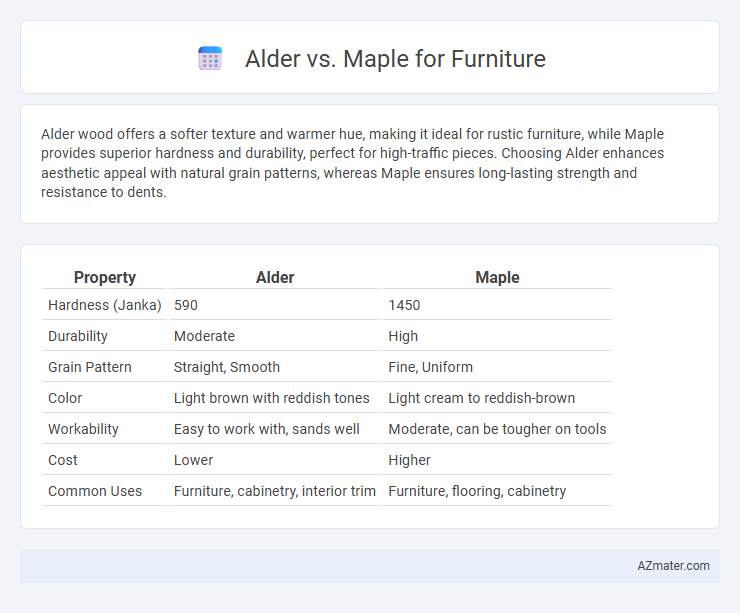Alder wood offers a softer texture and warmer hue, making it ideal for rustic furniture, while Maple provides superior hardness and durability, perfect for high-traffic pieces. Choosing Alder enhances aesthetic appeal with natural grain patterns, whereas Maple ensures long-lasting strength and resistance to dents.
Table of Comparison
| Property | Alder | Maple |
|---|---|---|
| Hardness (Janka) | 590 | 1450 |
| Durability | Moderate | High |
| Grain Pattern | Straight, Smooth | Fine, Uniform |
| Color | Light brown with reddish tones | Light cream to reddish-brown |
| Workability | Easy to work with, sands well | Moderate, can be tougher on tools |
| Cost | Lower | Higher |
| Common Uses | Furniture, cabinetry, interior trim | Furniture, flooring, cabinetry |
Overview: Alder vs Maple in Furniture Making
Alder and Maple are popular hardwood choices in furniture making, each offering distinct characteristics. Alder is softer, easier to carve, and has a warm, reddish-brown tone that ages beautifully, making it ideal for rustic or casual designs. Maple is harder, more durable, and features a fine, consistent grain with a lighter, creamy color suited for modern or formal furniture styles that require longevity.
Wood Characteristics: Grain, Color, and Texture
Alder wood features a fine, straight grain with occasional knots, offering a smooth texture and warm reddish-brown to light tan color that darkens naturally over time. Maple wood is known for its tight, uniform grain and smooth texture, often displaying creamy white to light reddish hues with subtle variations. Both woods provide durability for furniture, but alder's softer consistency makes it easier to carve, while maple's hardness offers superior resistance to dents and wear.
Durability and Strength Comparison
Maple wood is notably stronger and more durable than alder, making it ideal for furniture that requires long-lasting wear and resistance to dents and scratches. Alder is softer and less dense, resulting in a lighter, more affordable option but with reduced strength and susceptibility to damage over time. Choosing maple ensures greater structural integrity and longevity, especially for high-traffic or heavy-use furniture pieces.
Workability: Which Is Easier to Craft?
Alder wood is known for its superior workability compared to maple, making it easier to craft for furniture. It is softer and less dense, which allows for smoother cutting, shaping, and sanding, reducing wear on tools. Maple's hardness and tight grain structure require more effort and sharper tools, often challenging for intricate detailing or novice woodworkers.
Staining and Finishing Differences
Alder wood offers a smooth grain that absorbs stain evenly, resulting in a rich, uniform finish ideal for darker tones, while maple's tight, dense grain can cause blotchiness during staining, often requiring a pre-conditioner for consistent color. Finishing alder is straightforward due to its softness, allowing for easier sanding and a cleaner absorption of finishes, whereas maple's hardness demands more effort in surface preparation but provides a durable, long-lasting finish. Choosing between alder and maple for furniture depends on the desired stain outcome and finishing durability, with alder favored for warm, rustic looks and maple preferred for sleek, modern designs.
Cost Analysis: Alder vs Maple
Alder wood is generally more affordable than maple, making it a popular choice for budget-conscious furniture buyers seeking a warm, rustic appearance. Maple, while more expensive due to its hardness and durability, offers superior resistance to dents and scratches, extending furniture lifespan. The cost difference between alder and maple can vary by region, but alder typically costs 20-30% less per board foot, influencing the overall budget for furniture projects.
Environmental Impact and Sustainability
Alder wood, sourced primarily from fast-growing trees in managed forests, offers a more sustainable option compared to maple due to its shorter harvest cycle and lower carbon footprint during cultivation. Maple, often harvested from slower-growing hardwood forests, can have a higher environmental impact linked to longer growth periods and more intensive resource use. Choosing alder furniture supports reduced deforestation and promotes eco-friendly forestry practices, aligning with green consumer values.
Popular Furniture Styles Using Each Wood
Alder wood is favored in rustic and farmhouse furniture styles due to its warm tones and soft texture, creating a cozy, natural look ideal for cabinets and tables. Maple is popular in modern and contemporary furniture for its durability and fine grain, delivering a smooth finish perfect for sleek, minimalist designs like dressers and desks. Both woods support diverse furniture aesthetics but cater to distinctly different visual and functional preferences.
Maintenance and Longevity Factors
Alder wood offers softer grain and easier repairability, making it ideal for furniture that may experience frequent wear, while maple is harder and more durable, providing superior resistance to dents and scratches over time. Maple's dense grain helps maintain its structural integrity and appearance longer, requiring less frequent refinishing compared to alder, which can show signs of aging faster due to its softer texture. Proper sealing and regular cleaning extend the longevity of both woods, but maple's natural toughness generally results in lower maintenance demands for lasting furniture quality.
Choosing the Right Wood for Your Furniture Needs
Alder wood is a soft hardwood valued for its smooth grain and warm reddish-brown hue, making it ideal for rustic and casual furniture styles. Maple offers greater hardness and durability with a fine, consistent grain, perfect for pieces requiring high resistance to wear and a sleek, modern look. Selecting between alder and maple depends on the desired balance of affordability, strength, and aesthetic appeal for your furniture project.

Infographic: Alder vs Maple for Furniture
 azmater.com
azmater.com